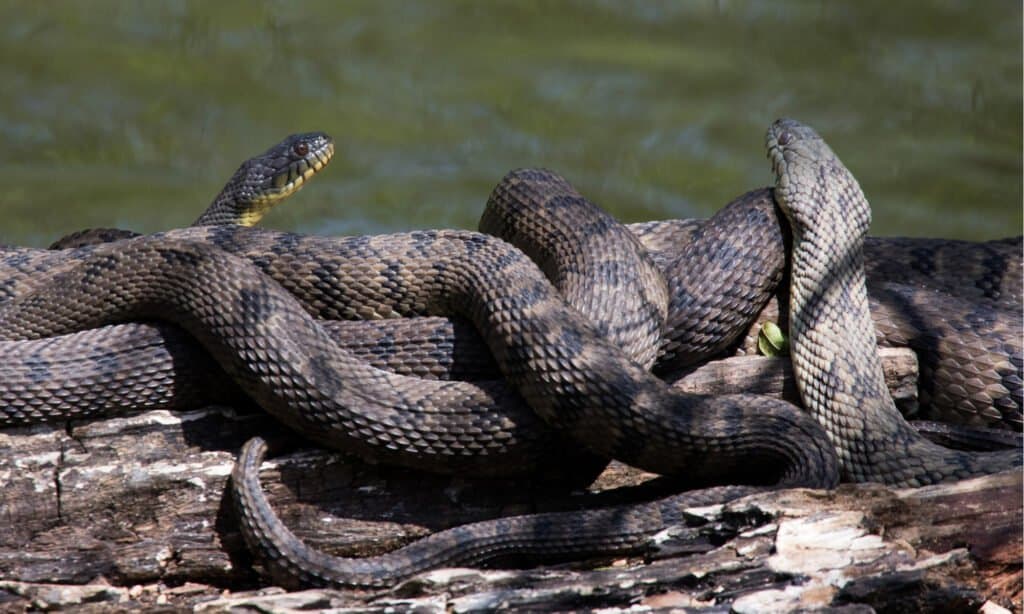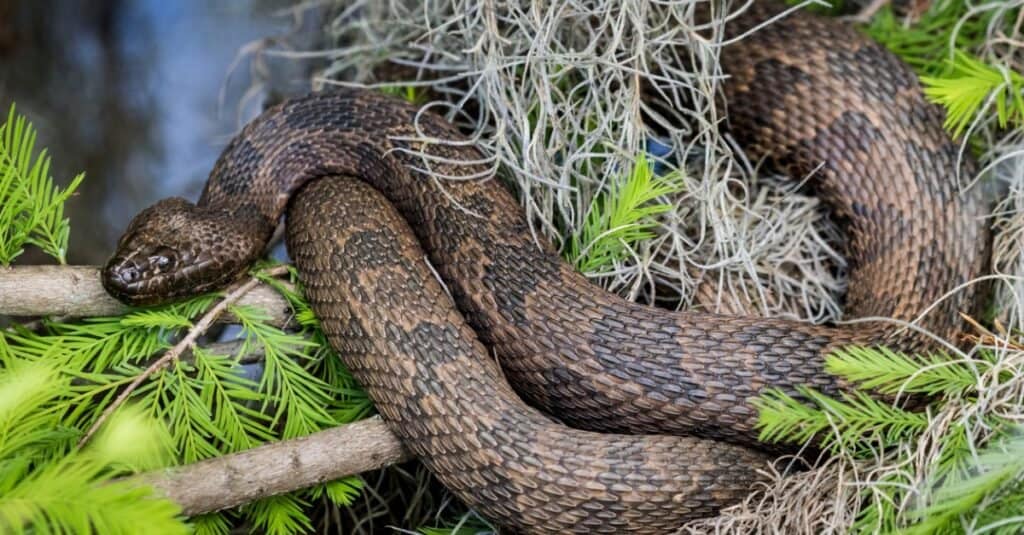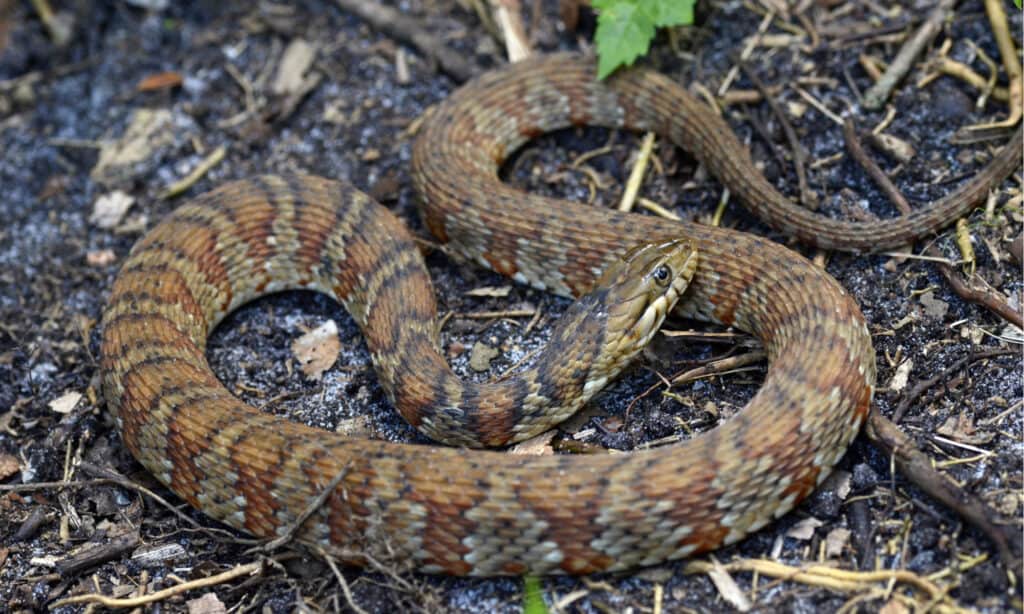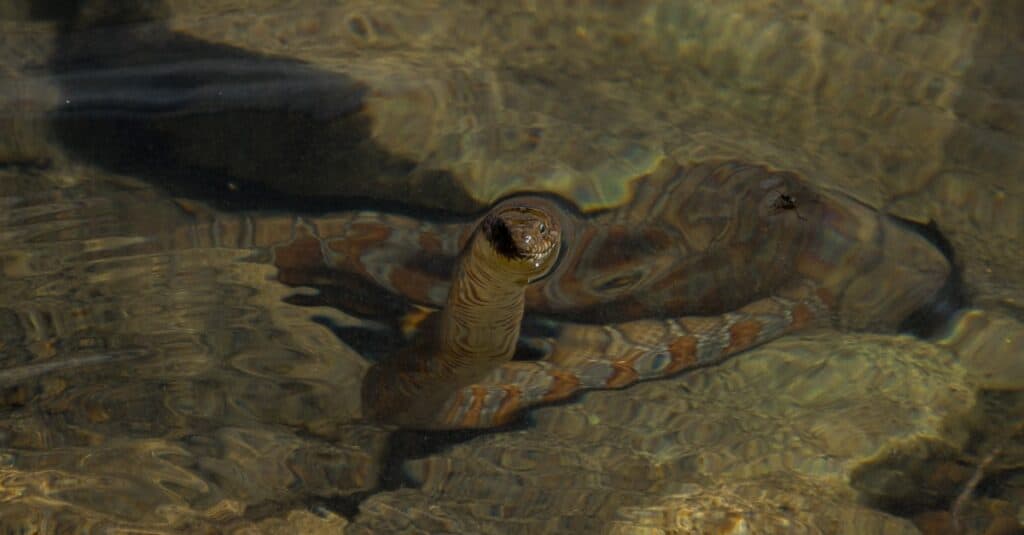There are many types of water snakes throughout the United States. They all belong to the Nerodia genus and their most distinctive characteristic is their semi-aquatic lifestyle. Some live all over the eastern United States, while others live only in select rivers.
Water snakes are not venomous, though some look similar to more dangerous snakes, like the cottonmouth. They range in size from just a couple of feet to around five feet long. Most are a brown or olive-green color with regular markings on their bodies. And they’re not dangerous to humans.
Let’s take a look at eight of the most common species of the water snake.
1. Diamondback Water Snake

The diamondback water snake’s scientific name is Nerodia rhombifer.
©Laurie L. Snidow/Shutterstock.com
Often confused with the similar-looking cottonmouth, diamondback water snakes are non-venomous and non-aggressive. They feed primarily on catfish, amphibians, smaller snakes, baby turtles, insects, crayfish, and small mammals. When threatened, they spray musk from their anal glands to deter predators.
Diamondback snakes live throughout the eastern United States near sources of permanent water like ponds, lakes, and rivers. These heavy-bodied snakes can grow up to five feet long, and produce up to 50 baby snakes with every birth. They’re yellow to brown in color with distinct dark markings that resemble a chainlink fence down the length of their bodies.
2. Brown Water Snake

The brown water snake’s scientific name is Nerodia taxispilota.
©iStock.com/csraphotography
Like the diamondback, the brown water snake feeds primarily on fish, preferring mostly catfish. It can grow up to five feet long and has thick, heavy bodies. Brown water snakes are exceptional swimmers and flee into the water when threatened. They’re only found near sources of permanent water, as fish make up most of their diet.
3. Banded Water Snake

Also known as the southern water snake, the banded water snake’s scientific name is Nerodia fasciata.
©Patrick K. Campbell/Shutterstock.com
Banded water snakes live in the southern United States from Texas to Florida. They prefer slowly moving water sources, like rivers, cypress creeks, and canals, but also live in lakes and marshlands. Their prey mostly consists of frogs, newts, salamanders, toads, crayfish, fish, and tadpoles. They’re not aggressive but will bite if threatened or provoked. Females produce 15-20 young per birth.
The banded water snake’s coloring ranges from yellow-red to brown-gray, with darker stripes along the back, and a pale belly. It is smaller than other species of water snake, topping out at 3-3.5 feet long, but has a heavy body for its size.
4. Northern Water Snake

The northern water snake’s scientific name is Nerodia sipedon.
©iStock.com/manuellacoste
Northern water snakes live in many parts of the eastern United States. Unlike many species of water snake though, they’re not found in Florida, or along the southeastern coast. They also live as far north as the southern shores of the Great Lakes. They’re most likely to be seen in ponds, rivers, lakes, and swamps.
Northern water snakes eat amphibians and fish; they’re semi-aquatic and leave the water to bask in the sun. Like many species of water snakes, they like laying on rocks near the water or hanging out in branches that overhang the water. They grow to between 2-4.5 feet long and can be recognized by their yellow to gray bodies with darker splotches.
5. Plain-Bellied Water Snake

A plain belly water snake sunning itself beside a lake; these snakes’ bellies have no markings and vary from yellow to red.
©iStock.com/lbolton09
These snakes can grow up to four feet long; unfortunately, people often mistake them for the venomous cottonmouth and kill them on sight. They eat salamanders, frogs, toads, fish, and crayfish. Unlike other species of water snake, the plain-bellied water snake (and its subspecies) flees to dry land when threatened. Males are smaller than females that can produce up to 55 young per birth.
6. Green Water Snake

Green water snakes are also known as Mississippi green water snakes.
©Ryan M. Bolton/Shutterstock.com
As its name suggests, the Mississippi green water snake can be found throughout Mississippi. It is also common as far north as Illinois, and as far east as Florida. Like other water snakes, they’re semi-aquatic and eat mostly fish, amphibians, and rodents.
Adult green water snakes can reach up to 4.5 feet in length. They have heavy bodies that tend towards dark-green with darker markings along the back and sides with pale bellies. They’re non-aggressive but will bite if threatened.
7. Concho Water Snake
This type of water snake is found only in a few restricted areas in Central Texas. It is considered endangered because of habitat loss, habitat fragmentation, and polluted water. Unlike other water snakes, which live in still waters, the Concho water snake inhabits only flowing rivers.
Concho water snakes are small for water snakes – adults top out around three feet long. They range from tan to red-brown in color, with slightly darker checkerboard markings along their backs. Their diet consists almost entirely of fish and minnows.
8. Brazos Water Snake

Brazos water snakes are named for the only river in the world where they can be found – the Brazos River, in Texas. Because of their rarity, they’re listed as a threatened species. Like the Concho water snake, the Brazos water snake inhabits only flowing sources of water. They prefer areas with little vegetation, preferring instead rocky rivers with rock outcroppings to bask on.
These snakes range from dun-colored to green or gray. They have four rows of checkerboard patterned darker splotches and pale bellies. Their heads are more triangular in shape than other species of water snakes. But, they’re non-venomous, and not dangerous to humans.
Summary of 8 Types of Water Snakes
Here is a summary of the 8 types of water snakes and where they are located:
| Number | Snake | Location |
|---|---|---|
| 1 | Diamondback Water Snake | Eastern U.S. |
| 2 | Brown Water Snake | South Virginia to Florida |
| 3 | Banded Water Snake | N. and S. Carolina, Georgia, Florida |
| 4 | Northern Water Snake | Eastern U.S. and Great Lakes region |
| 5 | Plain-Bellied Water Snake | Southeastern U.S. |
| 6 | Green Water Snake | Mississippi |
| 7 | Concho Water Snake | Central Texas |
| 8 | Brazos Water Snake | Brazos River, Texas |
The photo featured at the top of this post is © iStock.com/Dalene Capps
Discover the "Monster" Snake 5X Bigger than an Anaconda
Every day A-Z Animals sends out some of the most incredible facts in the world from our free newsletter. Want to discover the 10 most beautiful snakes in the world, a "snake island" where you're never more than 3 feet from danger, or a "monster" snake 5X larger than an anaconda? Then sign up right now and you'll start receiving our daily newsletter absolutely free.
Thank you for reading! Have some feedback for us? Contact the AZ Animals editorial team.






